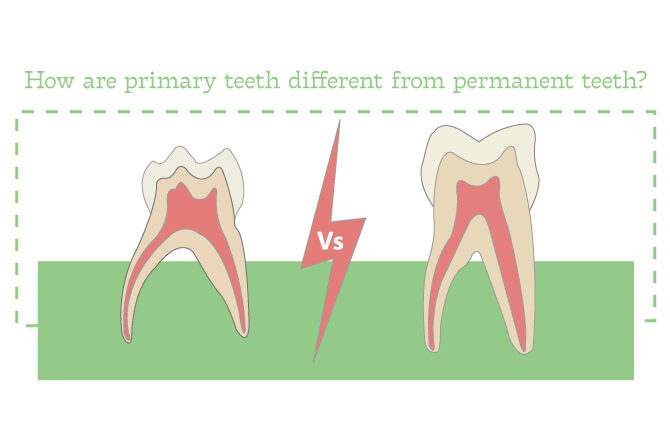
How are Primary Teeth Different from Permanent Teeth?
What are primary teeth and when do they first appear?
As it is a known fact that there are two sets of teeth that appear at different times in each human being, the first set to appear in children are known are primary ones. These teeth are also known as deciduous teeth in the dental sphere. The interesting thing to know about these teeth is that they are temporary and are lost after certain period of time to give way for permanent teeth. The age at which these teeth first appear can vary but generally, they appear after 8 months.
Primary teeth Vs Permanent teeth: An overview
- The most significant thing to know u deciduous or primary teeth is that they have thinner enamel than their permanent teeth counterparts.
- Figuratively there is on average 1 mm thickness between the enamel of permanent and deciduous teeth.
- It is also speculated that the enamel is more uniform in depth around the tooth while as in permanent teeth, the depth of enamel varies from one position of the tooth to next.
- Furthermore the dentin layer is also thinner in baby teeth than the permanent set of teeth.
- Because of these things, the pulp in the primary tooth is thicker in comparison.
- Also, as these teeth are not that much protected by the mineralized layer, they remain at high risk of tooth wear, caries and pulp therapy exposure when preparing them for restorations.
- Due to the thin enamel, teeth of children usually appear whiter.
- Moreover there is also a difference between the enamel rods of primary and secondary teeth. While in secondary ones, these rods are perpendicular to the dentin, in deciduous teeth these rods point up occlusal. The roots of primary teeth are more divergent than the permanent ones
How are deciduous teeth different from each other?
Primary central incisor
This is the widest anterior mesiodistal tooth. In fact, this is the only anterior tooth in which the width is greater than height
Primary lateral incisor
There is not much difference in this tooth when compared to central incisor. However, this tooth is not as much wider as the central incisor.
Primary canine
While looking in the facial lingual direction, primary upper canine may appear the widest anterior tooth. It has a longer and sharper cusp than the lower canine. The lower primary canine is the most symmetric of all teeth
Primary 1st molars
There are a lot of things to know when it comes to these primary teeth. The crown treatment of lower molars resembles that of permanent premolars with an added small distal segment. These deciduous teeth are replaced by permanent 1st premolars. It has a prominent cervical budge which can be clearly seen by the occlusal view. The three root form of these teeth resembles that of permanent molars. However, the primary lower 1st molars are the most unique and primitive looking teeth
Primary 2nd molars
This is the widest primary tooth in the facial lingual direction. The crown of these teeth is akin to permanent 1st molars.
Is there a specific way for protecting deciduous teeth?
Protecting primary teeth is not as simple as brushing teeth two times a day. In fact, the general protocols for taking care of these teeth differ from one developmental stage of a baby to another. It is not advised for baby less than 6 months of age to brush the gums. However, parents should keep the gums of these babies clean with the help of a cloth. As the first primary teeth appear, you are advised to brush them with specific toothbrush, usually very soft, and specific toothpaste. You will see your infant babies in irritating state when their primary teeth appear. This is because there gums are not acquainted with having teeth like structures in them. Your pediatric dentist will generally advice you to give them a soother to bite and also sooth them with cold cloth.
Why do some babies retain their primary teeth
Retained teeth are nor that uncommon in the world. However, it is true that falling of deciduous teeth is a good thing for babies. This is because the permanent set of teeth always tends to erupt in their own time. This can lead to certain problems such as:
- Teeth moving below the adjacent teeth due to their incapacity to touch surfaces while biting
- Problems related to the alignment of teeth
- Unusual spaces between the teeth
- Irritation in gums and toothache
Conclusion
Primary teeth are very different from permanent teeth in eruption, anatomy and even the period of retaining. The care that a set of secondary teeth require completely varies from that required by deciduous teeth. As there are many developmental stages in primary teeth, there are lot complications that can occur in them. People should not avoid these problems by thinking of the temporary nature of these teeth as these problems can lead to disastrous conditions in permanent teeth too. To know more about the teeth of your children and how to keep them safe, contact Kids dental Studio.
Leave a reply
Leave a reply